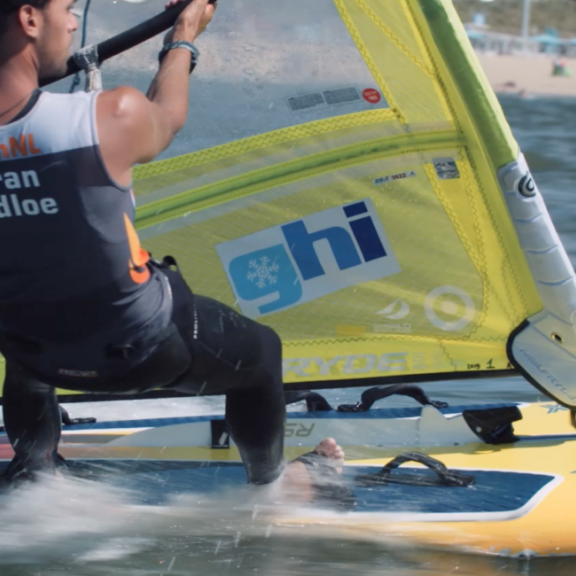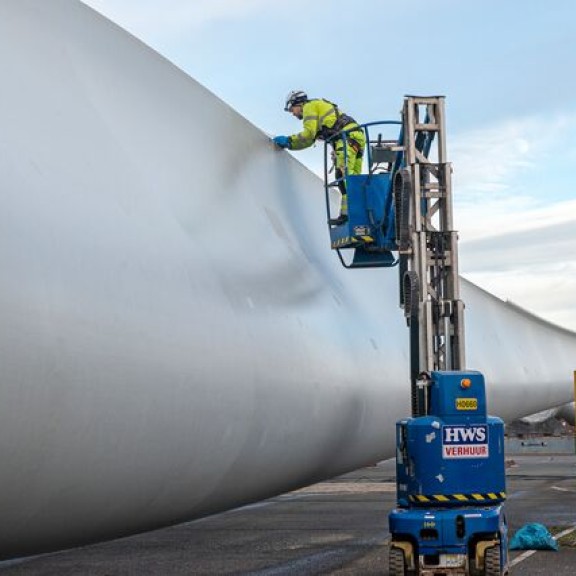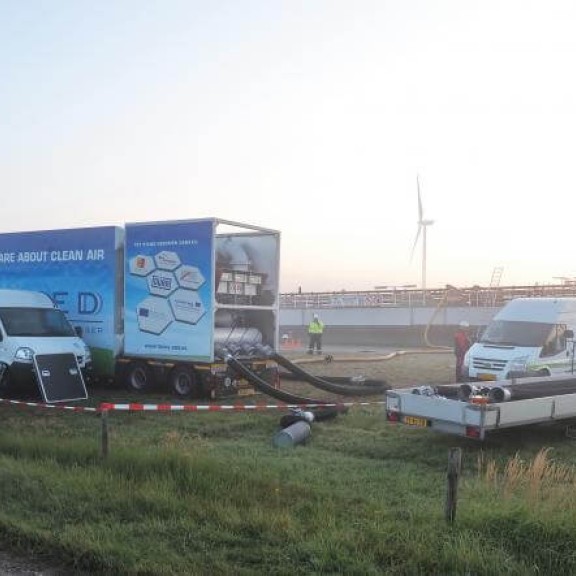
Setting the course for the Netherlands Hydrogenland now
With less than 100 days to go until the postponed Olympic Games in Tokyo, the leaders of Nederland Waterstofland are seizing the moment to draw attention to the strength of the Netherlands as a hydrogen country.
Under the name Mission H2, an initiative of Gasunie, Groningen Seaports, Remeha, Shell, Stedin Group, Toyota and Port of Amsterdam, together with the ambassadors of TeamNL, awareness is generated for hydrogen as a pillar underpinning the climate ambitions of the Netherlands. The campaign with the message "Together we will make the Netherlands Hydrogen Land" was launched today.
In the campaign, Olympic sports personalities Marit Bouwmeester, Kiran Badloe, Ferry Weertman and other Olympic and Paralympic water sport heroes show that if we choose the right course now, we will all soon experience the dazzling energy of hydrogen. And that is necessary. Because if we do not scale up to large-scale hydrogen applications now, we will lag behind our neighbours, we will not achieve our climate targets and we will not make sufficient use of the national earning power of hydrogen. Reason enough for this hydrogen consortium to sound the alarm!
Thanks to its links with wind and water, the Netherlands is excellently positioned to become the hydrogen country of Europe. We have everything: the North Sea for offshore wind, seaports, knowledge and infrastructure. But then we have to get going today: Together we will make the Netherlands hydrogen country!
Vision, decisiveness and acceleration
Last week no fewer than 80 Dutch companies presented their hydrogen commitments to the government. In doing so, the Dutch business community demonstrated its decisiveness and willingness to invest in accelerating the hydrogen economy, for employment, the economy and the climate. The next move is up to the government!
Ulco Vermeulen, Executive Board of Gasunie, one of the Mission H2 partners: 'The comparison between hydrogen transition and top-class sport is perfect. At this very moment national sports federations, Olympic and Paralympic committees and above all our athletes are preparing with full dedication and unanimity for the biggest sports event in the world. That is exactly why we are now fully committed to a green future with hydrogen. The government, the business community and knowledge institutes must now show the same vision, focus and decisiveness as our top athletes. We won't make it with less.
Collaboration TeamNL & water sports unions
The campaign is being run in close cooperation with TeamNL and the water sports associations KNZB, KNRB and Watersportverbond. Our water sports enthusiasts know the power of wind and water like no other. That is why we are so proud of our multiple Olympic, Paralympic, World, European and Dutch champions: Marit Bouwmeester, Ferry Weertman, Kiran Badloe, Liesette Bruinsma, Ilse Paulis & Marieke Keijser.

How to make offshore wind circular?
By: Dorothy Winters, programme manager Offshore Wind, Amsterdam IJmuiden Offshore Ports (AYOP)
Offshore wind is one of the fastest growing sectors, with Europe investing some 26 billion euros in wind at sea during 2020 alone. Wind is one of the main components for generating sustainable electricity as part of the energy transition. With the first generation of wind turbines from the period 2007-2008 reaching the end of their lifespan, the sector is facing new challenges with regards to circular decommissioning.
The offshore wind industry is becoming increasingly aware that while it designs, builds and maintains, it was until recently set up in a linear way. In other words, there are no functions for wind turbines after use. James Hallworth, Allard Klinkers (both from Port of Amsterdam) and Dorothy Winters (AYOP) participated in a number of sessions in recent months focused on the sustainability and circularity of wind turbines.
The circular perspective is a broader subject than offshore wind alone of course. Port of Amsterdam and the Amsterdam Metropolitan Region are now considering how the linear approach can be translated into a circular one.
Challenges
The development of circular wind turbines comprises various focal points, three of which are covered in this article: the continuous development of the turbine, the differences between various turbine generations, and challenges related to composite processing.
Fast development
A major demand for wind energy combined with a strong technological development is literally making the turbines grow in height, volume and weight within a substantially price-driven background. The focus is on making everything stronger, lighter in weight, larger and, therefore, more efficient. Circularity has not been sufficiently taken into account.
Multiple generations
There are differences between the various generations of turbines. The materials used in a blade in the first generation were not applied in later ones. This also means that solutions we can apply now to the first generation may not be easily transferable to the second or third generation, and so forth. The first generation of turbines were so ‘battered’ by the saline offshore conditions that their parts are no longer suitable for reuse.
Composite challenge
The blades are made from composite combined with other materials such as wood, fibre, resins and glues; materials that are difficult to separate into individual elements. As the first blades return from sea there are only a few possible applications for reuse, such as reinforcing concrete, placing in playgrounds or as roofing for bicycle sheds. It is important to note that although the volumes of the blades are a significant part of the turbine, they are relatively small for a specific composite processing market on an industrial scale.
What can we learn from other sectors?
Looking at the production, construction and dismantling of offshore wind equipment and the related electrical infrastructure, there is plenty of common ground with other sectors. The production industry, high-tech sector, logistics, maritime, offshore oil & gas, data-driven maintenance, energy and infrastructure; our North Sea Canal region features a wide diversity of industries. So which examples do we see around us that can be applied to offshore wind? And what can we learn from other sectors?
Integrated design
Like cars, wind turbines have a LEGO-like design and include parts from various suppliers. In contrast to electrical plants, for example, the lack of design integration is an issue during the decommissioning process. Manufacturers look almost exclusively at their own components. We believe that exchanging options and opportunities could reap rewards and help avoid dismantling risks. Rather than simply reversing the construction process, things should be set up so that the parts can be reused.
Service concepts
Nowadays, you can lease a car or office lighting, and the batteries of your Tesla remain the property of the builder. New business models are popping up in various sectors such as car sharing or leasing household appliances. Ensuring that a turbine remains the property of the builder or OEM avoids discussions about ownership and who’s responsible for decommissioning.
Reusing parts
On land we see that revised wind turbines find a second life at other locations. When repairs are needed turbine manufacturers just replace the relevant parts. In the aircraft industry, a sector with similarly high standards, there is a market for revised parts – with certification. This means that data-driven maintenance would have benefits during use as well as enabling a proper inventory for an end-of-life turbine.
How can the region contribute?
Our region has a healthy ecosystem for high-quality circular processing within a range of 30 kilometres. The success of this ecosystem relies on various factors: knowledge of materials, experience in reuse and processing, and logistical expertise.
Material expertise
The North Sea Canal region and Amsterdam Metropolitan Region accommodate a broad range of highly technical companies. From the processing of electronics, fibres and end-of-life plastics or composites to environmental expertise, applied research and non-destructive testing, these organisations could play a role in assessing the materials and options for reuse and even function as potential buyers.
Experience & space
Circular activities are already ongoing with sectors such as waste processing becoming increasingly refined. There are many companies with knowledge and expertise related to circularity which they can apply to turbine materials. The potential for our sector lies with a broad number of companies and start-ups that apply these techniques in other sectors, but have yet to enter the offshore wind sector. A decommissioning location in the Amsterdam port would provide the space for these activities.
Logistics
Decommissioning does not revolve around reverse logistics, or dismantling something in the way it was built. The next stage should determine how the dismantling and transportation are set up. Whether a blade is used to provide shelter at a bus stop or for a pyrolysis process to create an oil product defines how the dismantling takes place. Moreover, accommodation and processing within a range of 30 kilometres prevents unnecessary transportation of materials and provides a sustainable option.
Yes we can!
Various members of Amsterdam IJmuiden Offshore Ports are involved in decommissioning oil & gas platforms. It is good (and promising) to see they have already jointly determined that it is feasible to make a circular case commercially successful. And this is Port of Amsterdam’s and Amsterdam IJmuiden Offshore Ports’ aim for offshore wind, too. In a region that represents the entire chain, our knowledge and experience can contribute to smart solutions. Together, we can learn how to expand the applications at the end of a wind turbine’s lifespan and use this as input for designing the front.

First degassing tests for barges underway in Port of Amsterdam
A trial involving innovative vapour recovery systems was launched in the port of Amsterdam today. The aim is to enable barges to recover vapours safely and in a controlled manner to prevent them from being released into the air. This marks a significant step towards clean shipping.
Testing by two companies
The North Sea Canal Area Environment Agency has given two providers, Triple D and 24/7 Nature Power, the green light to test their vapour recovery systems at the ‘Groene Kade’ (‘Green Quay’) in the port of Amsterdam in the week of 21 September. Both companies use a vapour recovery plant based on the mobile condensation principle (24/7 Nature Power) and for the combustion of the vapours (Triple D).
Port of Amsterdam has been working for many years on creating the conditions for safe degassing in the port. It is providing access to the public ‘Groene Kade’ for the tests as part of its efforts to make the port sustainable.
The Environment Agency, too, has been working on preventing illegal degassing for some time. Sensory systems known as ‘eNoses’ are being used as watchdogs to prevent illegal degassing, for example. This test represents an important next step.
Permit if successful
The tests involve establishing how the equipment is performing in terms of reducing the emissions of benzene and residual vapours containing benzene.
This determines whether the plant in question is meeting the set requirements. If the trials are successful, the providers will be able to apply to the North Sea Canal Area Environment Agency for a permit.
Independent measurements
The North Sea Canal Area Environment Agency has commissioned an independent agency to conduct the test measurements that can be used to establish whether the plants meet the strictest requirements or require further improvement.
Prohibition on degassing during passage
Air quality is adversely affected by vessels degassing during passage in the inland navigation routes. This affects the health of local residents and the people working with these substances. On 1 March 2017 the Province of Noord-Holland banned the practice of degassing benzene and substances containing benzene as a measure to improve the environment and clean up inland navigation.
The industry has already succeeded in achieving a significant reduction in emissions in recent years, but this has not yet led to degassing being entirely ruled out. For that reason, the prohibitions are being extended in phases during 2020 into a national ban that will reduce the emission of these harmful substances by 98%.
National Taskforce on Degassing During Passage
The results of the trials are being evaluated in the ‘Taskforce on Degassing During Passage.’ Cora van Nieuwenhuizen, Minister of Infrastructure and Water Management, set up this taskforce in 2018 to ensure the smooth introduction of the national ban.
The taskforce includes representatives of the central government, provincial authorities, ports, shipping companies, carriers, warehousing companies and vapour recovery providers.
In introducing the national ban, it is important that an infrastructure is put in place that features plants that are able to process or recycle the residual cargo vapours.